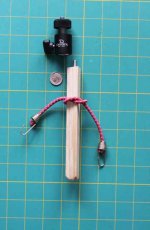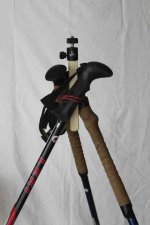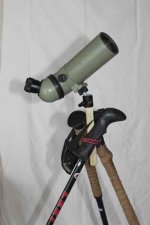I’d like to share an idea for one of the lightest possible ways to have a nice tripod available on hikes where birding with handheld binoculars or perhaps long distance hiking are the main activities. Backpackers and older day-hiker birders (I am one) usually seek to minimize the weight they carry and often leave heavy tripods and scopes in the car – relying only on binoculars. A trend emerging in the past few years for the same backpackers and the “creaky knees” crowd is the use of trekking poles, especially in the mountains with rough trails. If you hike with another person and both of you use hiking poles, you already carry the requisite three tripod legs and even have one extra! The trick is, how to assemble the poles you’re already carrying into a usable tripod.
I published an article last year in the Journal of the Glacier Mountaineering Society in Montana that described how mountaineers could make a tripod to hold their cameras for time delay “group summit photos” with only 3 ounces of extra carry weight. Since that mountaineering article is unlikely to be seen by birders, I’ll give a short description here.
You first need to obtain a 10-inch Mini-Bungee cord. A package of these is likely available at your local hardware store at low cost. After adjusting the three hiking poles to the same desired length and moving the wrist straps out of the way, wrap a bungee cord twice around the handles and secure the hooks on the bungee ends together. It is then simple to spread the pole bottoms out in tripod fashion. Rotate the poles so the grip contours fit together best. Secure the pole ends by pushing into the turf or between rocks, as this tripod does not have spreader braces. It will not work well on a smooth floor, but is fine nearly everywhere else. Most small bungee cords are stiff enough that one cord will hold very securely, but if you get a package of easily stretched ones, you may want to apply two bungees around the grips.
The next problem is how to secure the spotting scope on this ersatz tripod in a way that it can be easily pointed and locked in place. Looking down between the pole handles you’ll see a little triangle shaped opening. You’ll make a 6” (150 mm) long triangular wooden stick 3/4” (19 mm) on a side. I ripped mine on a table saw from a 1” (nominal) pine board, but you could even whittle one if you don’t mind spending a little more time. Round the triangle corners off with sandpaper if you saw-cut the piece, so they won’t cut the grips. Make the bottom end bluntly pointed so as to spread the pole handles when pushed down between them and make the top end flat. You can now drill a ¼ inch hole in that flat end and use epoxy cement to secure a 2 inch length of ¼-20 threaded rod in the hole. An easy way to get this is to buy a long threaded bolt and hacksaw off 2 inches of threading. Drill the hole in the wood deep enough so that just 5/16 inch (8 mm) of threaded rod protrudes. Allow the epoxy to harden.
To top off this stick, you’ll need to screw on a Mini-Ball Head and then attach your small spotting scope to that. I experimented with some mini-ball heads that cost under $3 but found they were not very secure. Nice full size ball heads work well, but are expensive and add needless weight. The best lightweight head I could find was the Giotto MH1004. It is rated to hold 2 kg, locks very securely, and costs about $15 USD. See attached photos:
1 Triangle stick, mini-ball head and 10” bungee cord
2 Triangle stick with mini ball head inserted into bungeed together grips
3 Tripod top with mini-ball head and spotting scope mounted.
This tripod is nice for viewing with small scopes, but not rigid enough for digiscoping. The mini-ball head is not so convenient as having a tilt and pan head, but is much smaller and lighter. The tripod will hold my Pentax PF65EDaII scope, but is not adequate for larger 80 mm scopes. It should be ideal for small 50 mm scopes like the angled Nikon ED50. While the height of the tripod can be adjusted down for seated use by changing the pole lengths, 45˚ or 90˚ angled eyepiece scopes work best since maximum ball head height for typical adjustable hiking poles is about 4 ½ feet or 135 cm. It cannot be raised to eye height for straight-through scope viewing while standing.
Hope you find this useful for times when you’d otherwise not carry a tripod or scope at all. Enjoy! - Bill
I published an article last year in the Journal of the Glacier Mountaineering Society in Montana that described how mountaineers could make a tripod to hold their cameras for time delay “group summit photos” with only 3 ounces of extra carry weight. Since that mountaineering article is unlikely to be seen by birders, I’ll give a short description here.
You first need to obtain a 10-inch Mini-Bungee cord. A package of these is likely available at your local hardware store at low cost. After adjusting the three hiking poles to the same desired length and moving the wrist straps out of the way, wrap a bungee cord twice around the handles and secure the hooks on the bungee ends together. It is then simple to spread the pole bottoms out in tripod fashion. Rotate the poles so the grip contours fit together best. Secure the pole ends by pushing into the turf or between rocks, as this tripod does not have spreader braces. It will not work well on a smooth floor, but is fine nearly everywhere else. Most small bungee cords are stiff enough that one cord will hold very securely, but if you get a package of easily stretched ones, you may want to apply two bungees around the grips.
The next problem is how to secure the spotting scope on this ersatz tripod in a way that it can be easily pointed and locked in place. Looking down between the pole handles you’ll see a little triangle shaped opening. You’ll make a 6” (150 mm) long triangular wooden stick 3/4” (19 mm) on a side. I ripped mine on a table saw from a 1” (nominal) pine board, but you could even whittle one if you don’t mind spending a little more time. Round the triangle corners off with sandpaper if you saw-cut the piece, so they won’t cut the grips. Make the bottom end bluntly pointed so as to spread the pole handles when pushed down between them and make the top end flat. You can now drill a ¼ inch hole in that flat end and use epoxy cement to secure a 2 inch length of ¼-20 threaded rod in the hole. An easy way to get this is to buy a long threaded bolt and hacksaw off 2 inches of threading. Drill the hole in the wood deep enough so that just 5/16 inch (8 mm) of threaded rod protrudes. Allow the epoxy to harden.
To top off this stick, you’ll need to screw on a Mini-Ball Head and then attach your small spotting scope to that. I experimented with some mini-ball heads that cost under $3 but found they were not very secure. Nice full size ball heads work well, but are expensive and add needless weight. The best lightweight head I could find was the Giotto MH1004. It is rated to hold 2 kg, locks very securely, and costs about $15 USD. See attached photos:
1 Triangle stick, mini-ball head and 10” bungee cord
2 Triangle stick with mini ball head inserted into bungeed together grips
3 Tripod top with mini-ball head and spotting scope mounted.
This tripod is nice for viewing with small scopes, but not rigid enough for digiscoping. The mini-ball head is not so convenient as having a tilt and pan head, but is much smaller and lighter. The tripod will hold my Pentax PF65EDaII scope, but is not adequate for larger 80 mm scopes. It should be ideal for small 50 mm scopes like the angled Nikon ED50. While the height of the tripod can be adjusted down for seated use by changing the pole lengths, 45˚ or 90˚ angled eyepiece scopes work best since maximum ball head height for typical adjustable hiking poles is about 4 ½ feet or 135 cm. It cannot be raised to eye height for straight-through scope viewing while standing.
Hope you find this useful for times when you’d otherwise not carry a tripod or scope at all. Enjoy! - Bill
Attachments
Last edited:






